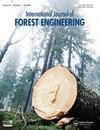Application of an Integrated Ergonomic Indicator (IEI) in evaluating forest machines
IF 2.1
3区 农林科学
Q2 FORESTRY
引用次数: 4
Abstract
ABSTRACT Ergonomic evaluations of forest machines are carried out in isolation due to the lack of an adequate method that makes it possible to correlate the ergonomic variables simultaneously. The aim of this study was to evaluate the ergonomic performance of certain forest machines by using the Integrated Ergonomic Indicator (IEI), capable of correlating ergonomic variables simultaneously. Vibration, noise, heat, illuminance, posture, repeatability, visibility and productivity were obtained from a feller buncher, harvester, forwarder, skidder and processor machines in two work shifts with 24 operators. The ergonomic data were subjected to cluster analysis and standardized by their deviations from the average, being subjected to multivariate factor analysis to determine influencing factors in the composition of the IEI. The indicator for each factor was multiplied by the variance explained for each factor, with the result divided by the total explained variance. The values remained around 0 and the higher the result, the worse the ergonomic condition. The results showed that the variables that most negatively influenced the machines were vibration, noise and lateral visibility which were related to each other. The worst machine under the ergonomic aspect was the skidder, with an IEI of 2.82 and 1.60 for day and night shifts, respectively, caused by shocks and bumps in the work route, and also due to the operators spending a long time with their neck rotated. The best machines were the 8×8 harvester and the forest processor at night, with an IEI of −1.36 and −0.96, caused by vibration, noise and neck with little rotational deviation.综合人机工程学指标在林业机械评价中的应用
摘要:由于缺乏能够同时关联人机工程学变量的适当方法,森林机械的人机工程学评估是孤立进行的。本研究的目的是通过使用能够同时关联人体工程学变量的综合人体工程学指标(IEI)来评估某些森林机器的人体工程学性能。振动、噪音、热量、照度、姿态、可重复性、能见度和生产率是从一台伐木机、收割机、货代、集材机和处理机上获得的,分两班,24名操作员。对人体工程学数据进行聚类分析,并根据其与平均值的偏差进行标准化,对其进行多元因素分析,以确定IEI组成中的影响因素。每个因素的指标乘以每个因素解释的方差,结果除以解释的方差总和。该值保持在0左右,结果越高,人体工程学条件越差。结果表明,对机器影响最大的变量是振动、噪声和横向能见度,它们相互关联。在人体工程学方面,最差的机器是滑板,白班和夜班的IEI分别为2.82和1.60,这是由于工作路线上的震动和颠簸造成的,也是由于操作员长时间转动脖子造成的。最好的机器是夜间的8×8收割机和森林处理机,IEI为−1.36和−0.96,这是由振动、噪音和颈部引起的,旋转偏差很小。
本文章由计算机程序翻译,如有差异,请以英文原文为准。
求助全文
约1分钟内获得全文
求助全文

 求助内容:
求助内容: 应助结果提醒方式:
应助结果提醒方式:


